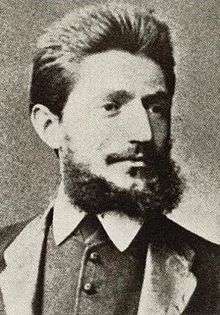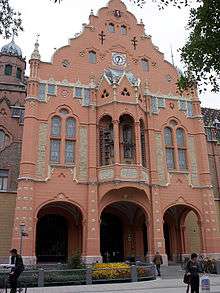Gyula Pártos
Gyula Pártos (born as Julius Puntzmann, 17 August 1845 – 22 December 1916) was a Hungarian architect.[1] Together with Ödön Lechner he designed a number of buildings in the typical Secession style of the turn of the century Hungary.
Gyula Pártos | |
|---|---|
 Gyula Pártos | |
| Born | Julius Puntzmann 17 August 1845 |
| Died | 22 December 1916 |
| Nationality | Hungarian |
| Alma mater | TU Berlin, Berlin |
| Occupation | Architect |
| Spouse(s) | Vittorina Bartolucci |
Career
At the beginning of his career he studied under Antal Szkalnitzky in Budapest, gaining his degree in Berlin in 1870. After this he established what was to be a fruitful partnership with Lechner which only ended in 1896, following the design of the Budapest Museum of Applied Arts. Working independently, he received some commissions in the capital as well as in Győr and Cegléd. Some of these followed in Lechner's footsteps but others leaned towards historicism.
Works

City Hall, Kecskemét, Hungary
- 1882 Szeged City Hall, together with Ödön Lechner
- 1882 - 1884 Hungarian Railway Pensioners Building (MÁV Nyugdíjintézet bérháza), Budapest, together with Ödön Lechner
- 1885-1886 Torontál County hall (today Zrenjanin City Hall, Serbia), together with Ödön Lechner.
- 1890 Gymnasium of Srijemski Karlovci, Kingdom of Croatia-Slavonia (today Sremski Karlovci, Serbia) together with Ödön Lechner
- 1893 Kecskemét City Hall, together with Ödön Lechner.
- 1900 Royal Hungarian Vocational School of Mechanics and Watchmaking, Budapest
- 1905 Black Eagle building in Hódmezővásárhely
gollark: So THAT'S why nobody uses other haskell compilers?
gollark: WHY?!
gollark: Dark wizardry!
gollark: You should, you see, use Rust.
gollark: Or sanity.
References
- Pártos Gyula, Hungarian Electronic Library, retrieved 13 May 2012 (in Hungarian)
| Wikimedia Commons has media related to Gyula Pártos. |
This article is issued from Wikipedia. The text is licensed under Creative Commons - Attribution - Sharealike. Additional terms may apply for the media files.